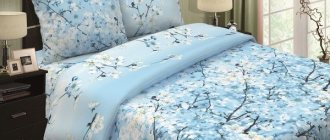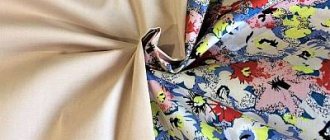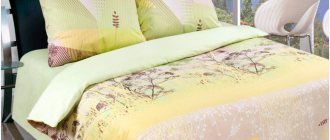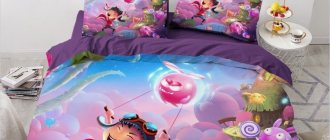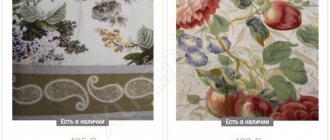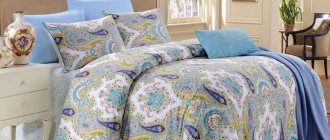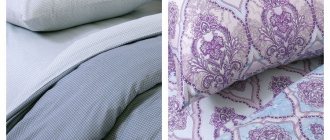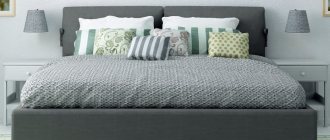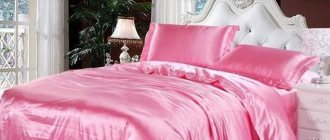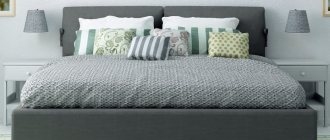Almost every person strives to make their “kingdom of sleep” as comfortable and convenient for relaxation as possible, so when it comes to choosing bedding, preference is given to natural sets. Despite the fact that today there is an incredible selection of synthetic fabrics, preference is still given to those products that have proven their reliability, durability and impeccable performance characteristics over many decades. One of the most popular fabrics from which bed linen is made, and which is chosen by many housewives, is calico bed linen. Why has this material gained immense popularity, and what types of calico exist? Who are these sets suitable for, and which bedding is better - calico or satin? The answers to these and many other questions are of interest to everyone who cares about the quality of their sleep. After reading our information, you will know absolutely everything about this material.
The appearance of calico
This natural material has been known in Rus' since ancient times. It appeared in the Moscow state thanks to merchants who imported calico from Asia back in the 16th century. The name itself is of Arabic origin. With the advent of the 18th century, this linen began to be produced in the Kineshma district and used to create linen for soldiers and caftans. A century later, specialists began to produce various types of calico, which became indispensable in the creation of women's and children's clothing items.
History of appearance
What calico is was learned in Rus' only in the 16th century. It was at this time that fabric began to be actively exported from the countries of the Far and Middle East. The material is completely natural and is made exclusively from cotton, which grows in warm climates.
Approximate calico fabric
Over time, production was established throughout Europe, and later all production was established in the United States. It was from this country that exports to Russia were made at the beginning of the 19th century. Over time, the domestic product supplanted the foreign one, captivating citizens with its quality and reasonable price.
What modern calico could be like
As production technology has evolved, the use of the material has also changed. At first, calico was used for sewing linings, military underwear, and summer dresses. Options that have already been improved over time have become the basis for sewing bed linen of the highest quality.
Why is it better to choose a calico set?
Calico sleeping set is the best choice because the material:
- washes well and does not lose its original appearance. Calico fabric can withstand an incredible number of washes, while maintaining the original size of the bed linen, color shades and patterns;
- very easy to iron, even without steaming;
- excellent air permeability, allowing the skin to breathe;
- absorbs sweat. Calico bed linen, the price of which is affordable for absolutely everyone, is hygroscopic, so it can give comfort even in hot weather;
- does not accumulate static electricity, which is also one of the most important characteristics;
- It has an affordable price, so if you want to buy bed linen inexpensively, then it should be a set of calico fabric.
Density options
Density is a characteristic of fabric indicating the weight of one m2. Depends on the weaving method. Deviations of 5-10 g are considered quite acceptable.
The following types of calico are distinguished by density:
- Sparse or thin with a density of 90 to 105 g/m2. It is translucent and looks simple. Shrinks when machine washed in hot water. Dries quickly and is cheaper than thicker options. Suitable for sewing bed linen in the budget category.
- Medium-density, the weight of 1 m2 ranges from 120 to 142 g. It is distinguished by high hygienic indicators, affordable price, practicality in use, and ease of maintenance. The fabric is made from threads No. 40 using the strong tension method. This makes it possible to produce a dense material that is resistant to mechanical stress, abrasion and tearing. The dense fabric produces an accurate and bright pattern that does not fade for a long time. When washed in cool water, the fabric does not shrink and is easy to iron.
- A bleached version of calico with a standard density of 142 g/m2. Thin snow-white fabric, pleasant to the touch, with an attractive appearance. Durable, high-quality textile accessories are sewn from it, in particular, medical gowns.
Blend calico fabric from the “Gold” category is produced using the usual linen method with the addition of polyester fibers. It has medium density. The synthetic component increases the wear resistance of the material, as well as tensile strength. The fabric does not wrinkle or shrink. Tactilely reminiscent of pure cotton, but less soft. It dyes well and retains its color after multiple washes. It is electrified, does not absorb water well, and also allows little air to pass through.
Important: Mixed calico is harmless, but it is better not to use it for underwear.
What types of calico are there?
Before choosing a set of bed linen, you should familiarize yourself with the varieties of this material, which is divided into types based on color and density. Today manufacturers offer the following types:
- Fabric "Severe". It is the densest and has a pale cream color. It is used in the creation of workwear, as well as in furniture production.
- Calico "Bleached". This material is somewhat thinner than harsh linen. It is used in sewing workwear and bed linen.
- Material "Plain painted". This type of calico has a structure similar to the previous type of fabric, but in this case the fabric is dyed and takes on a uniform appearance in various colors. The quality of this type of calico allows us to produce excellent bed linen and other products from it.
- Printed fabric. This raw material has a colored pattern and is best suited for creating children's clothing, as well as bed linen. This type of calico can be purchased in our online store - we recommend Euro calico bed linen.
A few words about how calico differs from other materials.
It is worth noting that many people, when buying a set of bed linen (calico), are very disappointed because it does not meet the stated characteristics. This phenomenon is quite understandable. The fact is that, according to established standards, calico is 100% cotton, but in the modern world they began to produce this fabric using synthetic threads. That is why, before making a purchase, read the composition of the material.
So, let's look at how calico differs from other natural fabrics. If you compare this material with:
- chintz, we note that these fabrics have the same weaving technique, but the chintz threads are much thinner. The colors are more durable and colorful in calico;
- satin: thanks to the technique of weaving threads, this material has acquired its shiny surface, which calico does not have. The appearance of satin is similar to silk, and its cost is higher compared to calico fabric. As for the strength of these fabrics, it is problematic to single out a specific option, since everything will depend on the characteristics of the composition and density of these fabrics;
- poplin: it is made using threads of different thicknesses. Initially, this fabric was silk, and calico was completely cotton. Modern poplin is increasingly found with the addition of synthetic fibers, as well as silk and wool threads. It all depends on the brand - manufacturer. The cost of such fabric is higher than the price of calico, while the latter type of fabric is more durable;
- percale: the difference between calico and this material can be seen with the naked eye. Despite the fact that these fabrics have the same weaving techniques, percale looks somewhat thinner and is more delicate to the touch. A sleeping set (calico) will be cheaper than percale bed linen.
To say exactly which bed linen is better, calico or satin, percale, etc. very difficult, because each manufacturer chooses different manufacturing technologies for such bedding.
Kinds
The following types of calico are distinguished:
- Severe, having the appearance of an unbleached, durable, rough, cream-colored fabric with a density of 100 to 142 g/m2 and a width of 90 to 164 cm. Workwear is sewn from it, suspended ceilings are made, as well as furniture upholstery.
- Bleached, pleasant to the touch with a density of 125 to 145 g/m2, width from 150 to 160 cm. Used for sewing medical gowns, as well as bedding sets.
- Printed calico for sewing kitchen textiles, nightgowns, pajamas, dresses, sundresses, bed linen.
- Smoothly dyed plain calico, from which tablecloths, bedding, as well as lining for jackets and trousers are sewn.
Table. Categories of calico
| Standard, comfort, light | Lux | Ranfors |
| Medium density fabric. | Fabric with a silk smooth surface, consisting of thinner threads. | Soft, durable, wear-resistant fabric in bright colors, reminiscent of poplin. Refers to premium textiles. The raw material is special yarn from expensive varieties of cotton. |
| Sewing children's, women's, and home clothes for the whole family. | Sewing high quality bedding sets. | Dress material for sewing clothes, home textiles. |
What standards must a sleeping set meet?
The main indicators that calico bed linen must meet are indicated by GOST 29298 2005.
The main characteristic of calico is the density of the fabric. Depending on these indicators, the canvas can be divided into the following categories:
- high density (125 g/m2). This is the best option for bedding sets, since the material has excellent performance and durability;
- average level of density (100 g/m2). Sleeping linen made from this material will also be an excellent choice for home use;
- low density (does not exceed 100 g/m2). This underwear is distinguished by its affordability and reduced wear resistance. With very frequent washing, bed linen will lose its original appearance.
Rules of care
In order for products to serve for many years, they need to be properly cared for. Clothes and bedding made from calico should be washed at a water temperature of 30 to 60 degrees. You can use various powders and conditioners, as the fabric is resistant to chemicals. To preserve the brightness of the color, the product must be turned inside out.
Dry in the usual way, hanging on a line. Machine drying is allowed. To make cotton items easy to iron, you should not overdry them; it is better to leave them a little damp.
Main characteristics
Calico, what it is and what the material looks like is a question that does not require an answer. Every home definitely has several products made from this type of textile. Calico is a natural material made from cotton. Refers to cotton types of textiles.
What calico looks like and what characteristics are inherent in it:
- The texture is uniform on both sides of the material.
- The width of the canvas can be 1.5 m or 2.2 m.
- The canvas has no shine with a glossy sheen.
- You can recognize the fabric by the cross weave of the threads.
- Completely hypoallergenic, as it contains only natural fibers.
- Easy to care for. The pattern is not washed off during washing. Does not fade in the sun.
The principle of weaving the fabric, which is related to the characteristics of the fabric
. Please note! You can check the quality by looking at the fabric against the light. If there are gaps between the weaves, then the density is low, and therefore the quality is too.
The properties of calico are directly determined by its composition. Mostly they are positive, but there is also a drawback - pellets quickly form on the canvas, which cannot be removed.
You might be interested in What is chesucha: description of wild silk and its use
Description and characteristics
For several centuries, calico has occupied a leading position in the ranking of fabrics. What kind of fabric is this that manufacturers not only do not want to give up, but are also working to improve the quality? It gained popularity due to its dense, uniform structure and matte surface. Cross-shaped plain weaving gives the finished product high practicality and durability. Bedding made from calico gives a comfortable sleep and is relatively inexpensive. According to the standard, it is made from 100% cotton, although the presence of synthetic fibers in varying percentages is allowed.
The quality of calico linen depends on the density. The thicker the fabric, the longer the bedding set will last. Density indicators of 140-150 g/m2 indicate that the canvas is good. In products that have a density of 90-110 g/m2, a clear weaving mesh with gaps between the threads is visible. This means that the material is second-rate. This type of bed is cheap, but not durable. Due to its loose texture it has a simple appearance.
Like all fabrics, calico has its pros and cons. Hygienic characteristics:
- absorbs excess moisture and remains dry to the touch;
- allows air to pass through;
- It does not require special care;
- washes well at low temperatures;
- keeps warm;
- has average creasing properties;
- environmentally friendly.
The positive aspects include resistance to mechanical stress, ruptures, and ultraviolet rays. Bed linen made from calico does not fade and retains the brightness of colors for many years. Warms in winter and cools in summer.
One big disadvantage is that natural cotton fabric shrinks after washing. If you wash calico in hot water, it will shrink, and maybe even significantly. This happens because the starch is washed out, the fabric shrinks and clumps tightly due to spinning. The state standard regulates that for high-quality material, shrinkage of up to 5% in the warp and up to 2% in the weft is allowed. If the sheet shrinks by 10 cm, then this is normal. The duvet cover shrinks even more. After the first wash, the factory-sized bedding will no longer accept, but with proper care you can avoid significant changes to the fabric.
How to soften calico bedding
If the only disadvantage of calico for you is its rigidity, then to solve this problem, use the following tips:
- wash clothes not with powders, but with gels, and also add rinse conditioner;
- do not over-dry the laundry so that it does not become “oaky”;
- use the steam mode while ironing, or start ironing while the fabric is still slightly damp;
- Use high temperatures when washing as little as possible, limiting yourself to programs with a temperature of 40 degrees.
Those who have chosen bedding made from calico will be able to fully appreciate its high quality characteristics. However, when choosing, take into account those few disadvantages - perhaps these factors are decisive for you.
Which bedding is better: calico, satin, percale or poplin
When a buyer is faced with a choice of which fabric to choose bed linen from, several main factors need to be taken into account:
- Naturalness. Calico and satin fully meet this parameter. Poplin and percale can be either completely natural or mixed: poplin combines cotton with silk, wool or synthetics, and percale with linen or polyester fibers.
- Hypoallergenic. Depends on composition and processing. As a result, the most hypoallergenic are calico and satin.
- Softness and smoothness. Compared to other fabrics, calico is somewhat coarser, but there is a way out here too - purchase luxury linen from calico or use softening products.
- Hygroscopicity and breathability. Calico has the highest indicator of these values due to its naturalness, the use of untwisted threads in weaving and relative looseness, justified by the use of thick threads.
- Low creasing is typical for satin, calico and poplin, while percale is one of the few disadvantages.
- Appearance. Satin and percale look the most rich, while poplin and calico are a little simpler.
- Price. Calico has an affordable price, poplin is a little more expensive, then percale and the most expensive - satin.
These are the parameters that people pay attention to when choosing a bedding set in the first place. There is no definite answer what is better for the consumer, since for one the price will be the priority, for another - naturalness, and for the third - beauty.
Different manufacturers - different calico
According to GOST in Russia, the material must contain fibers of natural origin. Each manufacturer from different countries uses a unique production technique, which has an insignificant, but significant effect on the characteristics of this type of textile:
- Chinese and Pakistani calico have polyester threads in their composition, which in percentage terms can be 15%.
- Belarusian calico is woven from natural cotton, but is processed using special technologies so that a slight glossy shine appears, the fabric is thin, pleasant to the touch, but lasts a long time.
- Russian - dense, with high density, determined by GOST. Lasts for a long time.
Quality depends on the manufacturer
If we consider European manufacturers, the principle of weaving and composition does not change radically.
Types of fabric densities
When choosing bed linen, you should pay attention to the density of the fabric
There are two main types.
- Linear.
- Superficial.
Linear and surface density are the most important quality indicators that determine strength, durability and wear resistance
Linear is measured by the number of threads per square centimeter, surface – g/m2. Each type of density has its own characteristics. Thus, superficial is an individual indicator. It is different for each type of textile. This indicator is influenced by several factors: the twisting of the fibers, the density of their fit, and the method of weaving together.
Linear density is the weight of the fabric per square meter. If the raw material contains few threads, then its indicator will be low. In many ways, the weight of the fabric depends on the thickness of the threads. The linear indicator can be low, below average, average, above average, high, elevated. The appearance of bed linen, its resistance to washing, transparency, and quality depend on two types of raw material densities.
Differences between calico and other cotton fabrics
The difference between this type of textile and other cotton “sisters” is not great, but it is still present. Most of all, people are interested in the difference between calico and cotton, if the composition is identical. The peculiarity lies in the interlacing of threads. With cotton it is more accurate and has a different principle of application.
Poplin also has differences in weaving. Threads of different thicknesses are used in relation to each other. But they are still much thinner than in a calico base.
In satin you can see threads of two thicknesses. The base is denser, and the thin one is twisted and passed through 3-5 intervals.
Knitwear can partially be classified in this comparison category. It is based on a combination of cotton, synthetic and woolen threads. To form the fabric, knitting is done by casting on small loops.
What bedding fabrics do we prefer?
Firstly, preference is given to natural fibers. Now we only have 100% HB. I hope that in the future we will maintain the strategy, maybe we’ll add flax. I won’t write platitudes about the natural hygroscopicity and breathability of cotton fabrics. Everyone knows that natural products are healthier than synthetics. I’ll just say something a little unobvious: pills appear on mixed fabrics, while pure cotton does not peel.
Secondly, we consider the fastness of paints to washing to be an important indicator of quality. Good fabric should not fade. We abandoned all unsustainable suppliers 3 years ago when the first complaints appeared.
The third important indicator for us is shrinkage within GOST, read about this in the article “What to do if the set shrinks?”
So, “Textilena” guarantees:
- compliance with the composition of the fabric indicated in the description and today it is 100% cotton,
- preservation of design and color with proper care,
- the size of the bed linen will remain the same even after the 5th wash (do not boil!)
Now I’ll help you figure out how the cotton fabrics for bed linen in our store differ from each other.
